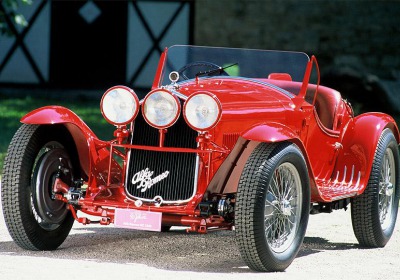Alfa Romeo, a look at the company's 100 years
Tue, 21 Dec 2010Alfa Romeo celebrated its centenary on June 24 as one of the most storied marques in automotive history, but its future remains uncertain.
A.L.F.A was founded in 1910 in Milan as Anonima Lombarda Fabbrica. A.L.F.A.'s first automobile was the 24 HP designed by Giuseppe Merosi. The HP included several advanced features such as a four-cylinder engine cast in a single block, an innovation that would remain a hallmark of the enterprise.
The 4.5-liter Merosi-designed Grand Prix car introduced in 1914 featured the first application of two spark plugs per cylinder.
Automobile production ended with the outbreak of World War I, and A.L.F.A. became part of the group of companies controlled by Nicola Romeo. Romeo later added his name, thus creating Alfa Romeo. The famous logo incorporates a red cross on a white background and a serpent, both symbolic of Milan's history.
The 1922 six-cylinder RL became the most powerful Alfa yet and is considered Merosi's masterpiece. RLs also won races, including the 1923 Targa Florio, where the winning car of Ugo Sivocci carried a green four-leaf clover on a white background--an emblem that would become the symbol of the Alfa Corse factory racing team.
Alfa Romeo pursued auto racing with vigor in the years following WWI, hiring engineer Vittorio Jano from Fiat in 1923. Jano set about creating an Alfa Romeo dynasty beginning with the P2 Grand Prix car that lasted until German teams steamrollered the competition in the mid- to late-1930s.
The Jano-designed six-cylinder 6C 1500 introduced in 1927 was a sales and sporting sensation. This car became the 6C 1750 with an enlarged engine in 1929, and it was also offered in Super Sport and Gran Sport versions with double overhead camshafts and supercharging. The 8C 2300 introduced in 1931 was designed around Jano's eight-cylinder engine that powered both Alfa Romeo racing and limited-production cars.
The 8C 2900 rolling chassis was sold to private owners in very limited numbers, custom-bodied by Italian carrozzeria including Zagato, Touring and Pininfarina. These cars have been called the first “supercars.” These hand-built automobiles were also the last of their kind, as Alfa Romeo was nationalized by the Italian government and the smaller 6C 2300/2500 was introduced in an effort to survive the unending Depression years.
World War II brought an end to production of both the Alfa Romeo 8C 2900 and the 6C 2500. The 6C 2500 re-entered production in 1946, but Alfa Romeo's first all-new postwar design was the 1900, introduced in 1950. The 1900 was built entirely on a production line, designed for a middle-class market and utilized unibody construction. In a nod to Alfa's coachbuilt past, the 1900 was also designed to enable the remaining Italian design houses to rebody the structure, which several did with pleasing results.
The Giulietta Sprint designed by Bertone and introduced in 1954 was the car that defined the postwar Alfa, however. The Giulietta was offered first as a stylish 1.3-liter coupe, followed by a Berlina and a Spider. The Giulia 1600 Sprint and Spider were introduced in 1962 with a 1.6-liter engine.
The Giulia Sprint GT introduced in 1963 was another landmark automobile for Alfa Romeo. The Sprint GT shared the 1.6-liter engine in a more modern Bertone-styled coupe, and the lightweight GTA version was enormously successful in racing in both Europe and the United States.
The Duetto Spider introduced in 1966 represented a highpoint for Alfa awareness in the States, being featured prominently with Dustin Hoffman in the movie The Graduate. New models introduced in the 1970s included the limited-production Montreal and the Alfetta GTV, while the Duetto carried on with a redesign as the Spider 2000.
Alfa Romeo became part of the Fiat-Lancia Group in 1986. The 164 Sport Sedan was offered in the United States to great anticipation, but support and service issues doomed the new model as well as Alfa's toehold on the U.S. market.
Alfa Romeos became increasingly limited in the States to vintage enthusiasts, while an exciting stream of new models could only be enjoyed in Europe.
The return of Alfa Romeo to the U.S. market has been promised many times, most recently as part of the working agreement between Chrysler and Fiat.
In the meantime, the Alfa Romeo brand struggles to maintain its identity in the most competitive automotive market in history. Fiat chief executive Sergio Marchionne said in January 2010, “We need to sell cars, not talk about history.”
By Leigh Dorrington

